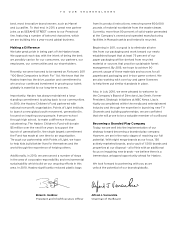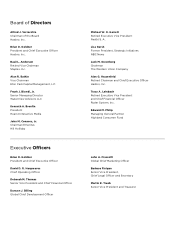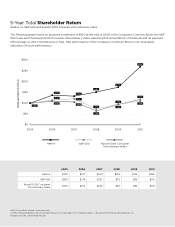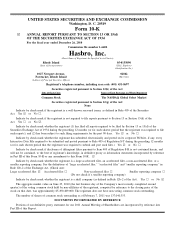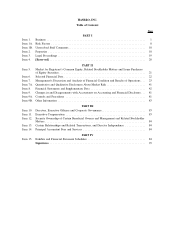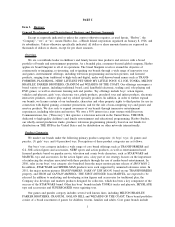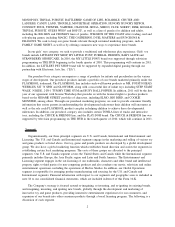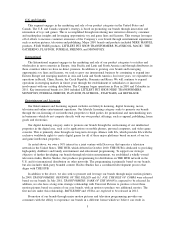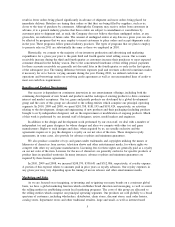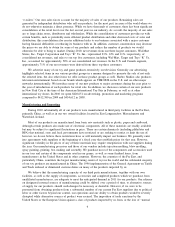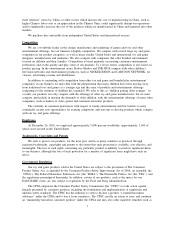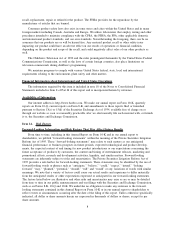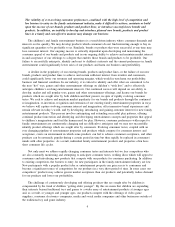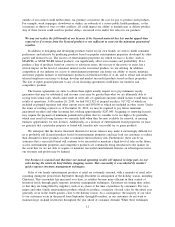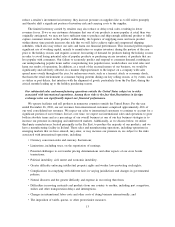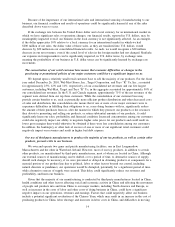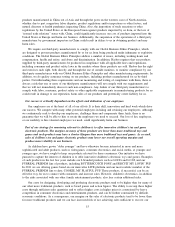Hasbro 2010 Annual Report Download - page 16
Download and view the complete annual report
Please find page 16 of the 2010 Hasbro annual report below. You can navigate through the pages in the report by either clicking on the pages listed below, or by using the keyword search tool below to find specific information within the annual report.
“e-tailers.” Our own sales forces account for the majority of sales of our products. Remaining sales are
generated by independent distributors who sell our products, for the most part, in areas of the world where we
do not otherwise maintain a direct presence. While we have thousands of customers, there has been significant
consolidation at the retail level over the last several years in our industry. As a result, the majority of our sales
are to large chain stores, distributors and wholesalers. While the consolidation of customers provides us with
certain benefits, such as potentially more efficient product distribution and other decreased costs of sales and
distribution, this consolidation also creates additional risks to our business associated with a major customer
having financial difficulties or reducing its business with us. In addition, customer concentration may decrease
the prices we are able to obtain for some of our products and reduce the number of products we would
otherwise be able to bring to market. During 2010, net revenues from our three largest customers, Wal-Mart
Stores, Inc., Target Corporation and Toys “R” Us, Inc., represented 23%, 12% and 11%, respectively, of
consolidated net revenues, and sales to our top five customers, including Wal-Mart, Target and Toys “R” Us,
Inc., accounted for approximately 50% of our consolidated net revenues. In the U.S. and Canada segment,
approximately 71% of our net revenues were derived from these top three customers.
We advertise many of our toy and game products extensively on television. Generally our advertising
highlights selected items in our various product groups in a manner designed to promote the sale of not only
the selected item, but also other items we offer in those product groups as well. Hasbro Studios also produces
television entertainment based on our brands which appears on THE HUB in the U.S. and on other major
networks internationally. We introduce many of our new products to major customers during the year prior to
the year of introduction of such products for retail sale. In addition, we showcase certain of our new products
in New York City at the time of the American International Toy Fair in February, as well as at other
international toy shows. In 2010 we spent $420,651 on advertising, promotion and marketing programs
compared to $412,580 in 2009 and $454,612 in 2008.
Manufacturing and Importing
During 2010 substantially all of our products were manufactured in third party facilities in the Far East,
primarily China, as well as in our two owned facilities located in East Longmeadow, Massachusetts and
Waterford, Ireland.
Most of our products are manufactured from basic raw materials such as plastic, paper and cardboard,
although certain products also make use of electronic components. All of these materials are readily available
but may be subject to significant fluctuations in price. There are certain chemicals (including phthalates and
BPA) that national, state and local governments have restricted or are seeking to restrict or limit the use of;
however, we do not believe these restrictions have or will materially impact our business. We generally enter
into agreements with suppliers at the beginning of a fiscal year that establish prices for that year. However,
significant volatility in the prices of any of these materials may require renegotiation with our suppliers during
the year. Our manufacturing processes and those of our vendors include injection molding, blow molding,
spray painting, printing, box making and assembly. We purchase most of the components and accessories used
in our toys and certain of the components used in our games, as well as some finished items, from
manufacturers in the United States and in other countries. However, the countries of the Far East, and
particularly China, constitute the largest manufacturing center of toys in the world and the substantial majority
of our toy products are manufactured in China. The 1996 implementation of the General Agreement on Tariffs
and Trade reduced or eliminated customs duties on many of the products imported by us.
We believe that the manufacturing capacity of our third party manufacturers, together with our own
facilities, as well as the supply of components, accessories and completed products which we purchase from
unaffiliated manufacturers, are adequate to meet the anticipated demand in 2011 for our products. Our reliance
on designated external sources of manufacturing could be shifted, over a period of time, to alternative sources
of supply for our products, should such changes be necessary or desirable. However, if we were to be
prevented from obtaining products from a substantial number of our current Far East suppliers due to political,
labor or other factors beyond our control, our operations and our ability to obtain products would be severely
disrupted while alternative sources of product were secured. The imposition of trade sanctions by the
United States or the European Union against a class of products imported by us from, or the loss of “normal
6


